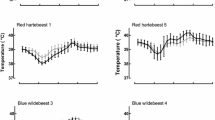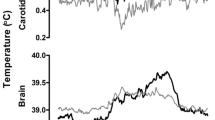Abstract
Marsupials reportedly can implement selective brain cooling despite lacking a carotid rete. We measured brain (hypothalamic) and carotid arterial blood temperatures every 5 min for 5, 17, and 63 days in spring in three free-living western grey kangaroos. Body temperature was highest during the night, and decreased rapidly early in the morning, reaching a nadir at 10:00. The highest body temperatures recorded occurred sporadically in the afternoon, presumably associated with exercise. Hypothalamic temperature consistently exceeded arterial blood temperature, by an average 0.3°C, except during these afternoon events when hypothalamic temperature lagged behind, and was occasionally lower than, the simultaneous arterial blood temperature. The reversal in temperatures resulted from the thermal inertia of the brain; changes in the brain to arterial blood temperature difference were related to the rate of change of arterial blood temperature on both heating and cooling (P < 0.001 for all three kangaroos). We conclude that these data are not evidence for active selective brain cooling in kangaroos. The effect of thermal inertia on brain temperature is larger than might be expected in the grey kangaroo, a discrepancy that we speculate derives from the unique vascular anatomy of the marsupial brain.





Similar content being viewed by others
References
Baker MA (1982) Brain cooling in endotherms in heat and exercise. Annu Rev Physiol 44:85–96
Baker MA, Hayward JN (1967) Carotid rete and brain temperature of cat. Nature 216:139–141
Baker MA, Hayward JN (1968) The influence of the nasal mucosa and the carotid rete upon hypothalamic temperature in sheep. J Physiol (Lond) 198:561–579
Baudinette RV (1984) Thermoregulation in marsupials during exercise. In: Hales JRS (ed) Thermal physiology. Raven Press, New York, pp 423–428
Brown GD, Dawson TJ (1977) Seasonal variations in the body temperatures of unrestrained kangaroos (Macropodidae: Marsupialia). Comp Biochem Physiol A 56:59–67
Caputa M, Kadziela W, Narebski J (1976) Significance of cranial circulation for the brain homeothermia in rabbits. I. The brain-arterial blood temperature gradient. Acta Neurobiol Exp (Warsz) 36:613–623
Caputa M, Kadziela W, Narebski J (1983) Cerebral temperature regulation in resting and running guinea-pigs (Cavia porcellus). J Therm Biol 8:265–272
Caputa M, Demicka A, Dokladny K, Kurowicka B (1996) Anatomical and physiological evidence for efficacious selective brain cooling in rats. J Therm Biol 21:21–28
Caughley G (1964) Social organisation and daily activity of the red kangaroo and the grey kangaroo. J Mammal 45:429–436
Caughley G, Grigg GC, Smith L (1985) The effect of drought on kangaroo populations. J Wildl Manage 49:679–685
Chesy G, Caputa M, Kadziela W, Kozak W, Lachowski A (1983) The influence of ambient temperature on brain homeothermia in the ox (Bos taurus). J Therm Biol 8:259–263
Craigie EH (1938) The blood vessels in the central nervous system of the kangaroo. Science 88:359–360
Dawson TJ (1973) Thermoregulatory responses of the arid zone kangaroos, Megalia rufa and Macropus robustus. Comp Biochem Physiol A 46:153–169
Dawson TJ (1995) Kangaroos: biology of the largest marsupials. UNSW Press, Sydney
Dawson TJ, May EL (1984) Daily variation in brain and body temperatures of the sugar glider (Petaurus breviceps): some insights into the control of thermoregulation. In: Smith AP, Hume ID (eds) Possums and gliders. Australian Mammal Society, Sydney, pp 375–383
Dawson TJ, Blaney CE, Munn AJ, Krockenberger A, Maloney SK (2000) Thermoregulation by kangaroos from mesic and arid habitats: Influence of temperature on routes of heat loss in eastern grey kangaroos (Macropus giganteus) and red kangaroos (Macropus rufus). Physiol Biochem Zool 73:374–381
Doolette DJ, Upton RN, Grant C (1999) Agreement between ultrasonic Doppler venous outflow and Kety and Schmidt estimates of cerebral blood flow. Clin Exp Pharmacol Physiol 26:736–740
du Boulay GH, Verity PM (1973) The cranial arteries of mammals. Whitefriars Press Ltd, London
Fuller A, Mitchell G, Mitchell D (1999a) Non-thermal signals govern selective brain cooling in pigs. J Comp Physiol B 169:605–611
Fuller A, Moss DG, Skinner JD, Jessen PT, Mitchell G, Mitchell D (1999b) Brain, abdominal and arterial blood temperatures of free-ranging eland in their natural habitat. Pflugers Arch 438:671–680
Fuller A, Maloney SK, Kamerman PR, Mitchell G, Mitchell D (2000) Absence of selective brain cooling in free-ranging zebras in their natural habitat. Exp Physiol 85:209–217
Fuller CA, Baker MA (1983) Selective regulation of brain and body temperatures in the squirrel monkey. Am J Physiol 245:R293–R297
Gordon CJ, Rezvani AH, Fruin ME, Trautwein S, Heath JE (1981) Rapid brain cooling in the free-running hamster Mesocricetus auratus. J Appl Physiol 51:1349–1354
Hayward JN, Baker MA (1968) Role of cerebral arterial blood in the regulation of brain temperature in the monkey. Am J Physiol 215:389–403
IUPS Thermal Commission (2001) Glossary of terms for thermal physiology: third edition. Jpn J Physiol 51:245–280
Jessen C (1998) Brain cooling: an economy mode of temperature regulation in artiodactyls. News Physiol Sci 13:281–286
Jessen C (2001) Selective brain cooling in mammals and birds. Jpn J Physiol 51:291–301
Jessen C, Laburn HP, Knight MH, Kuhnen G, Goelst K, Mitchell D (1994) Blood and brain temperatures of free-ranging black wildebeest in their natural environment. Am J Physiol Regul Integr Comp Physiol 36:R1528–R1536
Johnsen HK, Blix AS, Mercer JB, Bolz KD (1987) Selective cooling of the brain in reindeer. Am J Physiol 253:R848–R853
Kilgore DL, Boggs DF, Birchard GF (1979) Role of the rete mirabile ophthalmicum in maintaining the body to brain difference in pigeons. J Comp Physiol 129:119–122
Kluger MJ, D’Alecy LG (1975) Brain temperature during reversible upper respiratory bypass. J Appl Physiol 38:268–271
Kuhnen G, Jessen C (1991) Threshold and slope of selective brain cooling. Pflugers Arch 418:176–183
Lust A, Fuller A, Maloney SK, Mitchell D, Mitchell G (2007) Thermoregulation in pronghorn antelope (Antilocapra americana Ord) in the summer. J Exp Biol 210:2444–2452
Maloney SK, Fuller A, Mitchell G, Mitchell D (2001) Rectal temperature measurement results in artifactual evidence of selective brain cooling. Am J Physiol Regul Integr Comp Physiol 281:R108–R114
Maloney SK, Fuller A, Mitchell G, Mitchell D (2002) Brain and arterial blood temperatures of free-ranging oryx (Oryx gazella). Pflugers Arch 443:437–445
Maloney SK, Fuller A, Kamerman P, Mitchell G, Mitchell D (2004) Variation in body temperature in free-ranging western grey kangaroos (Macropus fuliginosus). Aust Mammal 26:135–144
Maloney SK, Mitchell D, Blache D (2007a) The contribution of carotid rete variability to brain temperature variability in sheep in a thermoneutral environment. Am J Physiol Regul Integr Comp Physiol 292:R1298–R1305
Maloney SK, Mitchell D, Mitchell G, Fuller A (2007b) Absence of selective brain cooling in unrestrained baboons exposed to heat. Am J Physiol Regul Integr Comp Physiol 292:R2059–R2067
McCarron HCK, Buffenstein R, Fanning FD, Dawson TJ (2001) Free-ranging heart rate, body temperature and energy metabolism in eastern grey kangaroos (Macropus giganteus) and red kangaroos (Macropus rufus) in the arid regions of South East Australia. J Comp Physiol B 171:401–411
McConaghy FF, Hales JRS, Rose RJ, Hodgson DR (1995) Selective brain cooling in the horse during exercise and environmental heat stress. J Appl Physiol 79:1849–1854
Mitchell G, Lust A (2008) The carotid rete and artiodactyl success. Biol Lett 4:415–418
Mitchell D, Maloney SK, Laburn HP, Knight MH, Kuhnen G, Jessen C (1997) Activity, blood temperature and brain temperature of free-ranging springbok. J Comp Physiol B 167:335–343
Mitchell D, Maloney SK, Jessen C, Laburn HP, Kamerman PR, Mitchell G, Fuller A (2002) Adaptive heterothermy and selective brain cooling in arid-zone mammals. Comp Biochem Physiol B 131:571–585
Mitchell G, Fuller A, Maloney SK, Rump N, Mitchell D (2006) Guttural pouches, brain temperature, and exercise in horses. Biol Lett 2:475–477
Nicol SC, Shah SKH (1989) Brain heat exchangers in marsupials. In: Mercer J (ed) Thermal physiology. Excerpta Medica, Amsterdam, pp 649–652
Nunneley SA, Nelson DA (1994) Limitations on arteriovenous cooling of the blood supply to the human brain. Eur J Appl Physiol Occup Physiol 69:474–479
Nybo L, Secher NH, Nielsen B (2002) Inadequate heat release from the human brain during prolonged exercise with hyperthermia. J Physiol (Lond) 545:697–704
Schumann P, Touzani O, Young AR, Verard L, Morello R, MacKenzie ET (1996) Effects of indomethacin on cerebral blood flow and oxygen metabolism: a positron emission tomographic investigation in the anaesthetized baboon. Neurosci Lett 220:137–141
Shah SKH, Nicol SC, Swain R (1986) Functional morphology of the cranial vasculature and the nasal passage in the Tasmanian Devil, Sarcophilus harrisii (Marsupialia, Dasyuridae)—a marsupial carotid rete? Aust J Zool 34:125–133
Sunderland S (1941) The vascular pattern in the central nervous system of the monotremes and Australian marsupials. J Comp Neurol 75:123–129
Swindle PF (1937) Occlusion of blood vessels by agglutinated red cells, mainly as seen in tadpoles and very young kangaroos. Am J Physiol 120:59–74
Taylor CR (1970) Dehydration and heat: effects on temperature regulation of East African ungulates. Am J Physiol 219:1136–1139
Waring H, Moir RJ, Tyndale-Biscoe CH (1966) Comparative physiology of marsupials. Adv Comp Physiol Biochem 2:237–376
Withers PC, Thompson GG, Seymour RS (2000) Metabolic physiology of the north-western marsupial mole Notoryctes caurinus (Marsupialia: Notoryctidae). Aust J Zool 48:241–258
Yablonskiy DA, Ackerman JJ, Raichle ME (2000) Coupling between changes in human brain temperature and oxidative metabolism during prolonged visual stimulation. Proc Natl Acad Sci USA 97:7603–7608
Zhu M, Ackerman JJH, Sukstanskii A, Yablonskiy DA (2006) How the body controls brain temperature: the temperature shielding effect of cerebral blood flow. J Appl Physiol 101:1481–1488
Acknowledgments
This research was supported by an Australian Research Council Discovery grant to S·K.M. and D.M., by the office of the Vice-Chancellor (Research) at UWA, and by the South African National Research Foundation. We thank the Harry Waring Reserve management committee for providing permission to use the reserve and Mr. Bob Cooper, the warden of the Reserve, for his generous help with logistics and animal monitoring. The Department of Conservation and Land Management, Western Australia, approved the use of native fauna in this project. Professor Graeme Martin and the School of Animal Biology, UWA, allowed us to use their 4WD vehicle.
Author information
Authors and Affiliations
Corresponding author
Additional information
Communicated by I. D. Hume.
Rights and permissions
About this article
Cite this article
Maloney, S.K., Fuller, A., Meyer, L.C.R. et al. Brain thermal inertia, but no evidence for selective brain cooling, in free-ranging western grey kangaroos (Macropus fuliginosus). J Comp Physiol B 179, 241–251 (2009). https://doi.org/10.1007/s00360-008-0308-2
Received:
Revised:
Accepted:
Published:
Issue Date:
DOI: https://doi.org/10.1007/s00360-008-0308-2




